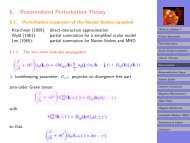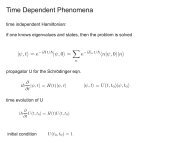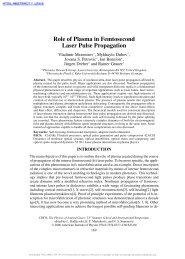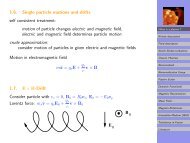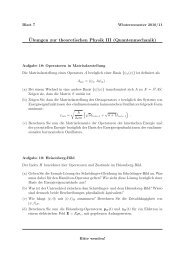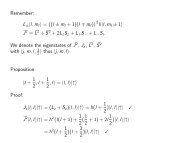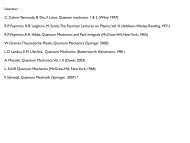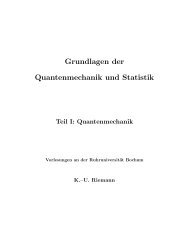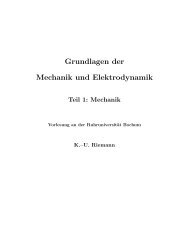Download (pdf 0.3MB) - Institut für Theoretische Physik I - Ruhr ...
Download (pdf 0.3MB) - Institut für Theoretische Physik I - Ruhr ...
Download (pdf 0.3MB) - Institut für Theoretische Physik I - Ruhr ...
You also want an ePaper? Increase the reach of your titles
YUMPU automatically turns print PDFs into web optimized ePapers that Google loves.
for each of the positions in the numerical scheme.<br />
Consequently, we find:<br />
and:<br />
lim<br />
∆t→0<br />
( )<br />
1 C<br />
n+1<br />
−ã+<br />
i<br />
∆t ˜∆x ¯ωn+1 i − ū n i−1/2<br />
i = u+ i−1/2 + ã− i+1/2 u− i+1/2<br />
˜∆x<br />
− (f(u− i+1/2 ) − f(u+ i−1/2 ))<br />
˜∆x<br />
+ 1 ∆t<br />
( ∆x<br />
∆˜x − 1 )<br />
ū n i (26)<br />
( )<br />
1 ∆x<br />
∆t ∆˜x − 1 ū n i = ( vi+1/2 0 − vi−1/2) 0 ūn i (27)<br />
Inserting this, together with the results for the other terms obtained above,<br />
into Eq. (17) yields:<br />
d<br />
dtūi(t) = − H i+1/2 − H i−1/2<br />
+ ( vi+1/2 ˜∆x<br />
0 − vi−1/2) 0 ūn i (28)<br />
where we introduced:<br />
H i+1/2 = −ã+ i+1/2 a− i+1/2 u+ i+1/2 − a+ i+1/2ã− i+1/2 u− i+1/2<br />
a + i+1/2 + a− i+1/2<br />
+ a+ i+1/2 f(u− i+1/2 ) + a− i+1/2 f(u+ i+1/2 )<br />
a + i+1/2 + a− i+1/2<br />
(29)<br />
Obviously we found a result very similar to that for the classical Cweno<br />
scheme. The main differences are that we have to distinguish between the two<br />
different kinds of velocities and that the resulting changes are given for the<br />
shifted grid. Also the correction term ( v 0 i+1/2 − v0 i−1/2)<br />
ūn i has to be included.<br />
This term ensures change of the cell average, whenever the cell size is modified.<br />
We note:<br />
• The resulting evolution requires a moving, generally non-uniform grid. The<br />
cell averages at the next timestep are in general given at a shifted position.<br />
This usually poses no problems (for limits on this see section 5). The<br />
main limitation in a one-dimensional computation is that one has to take<br />
the varying sizes of the individual cells into account, when computing the<br />
reconstruction for the next timestep. Whenever an output on an equidistant<br />
grid is desired or the individual cells get too big or too small the results can<br />
be projected back to the original grid.<br />
11



